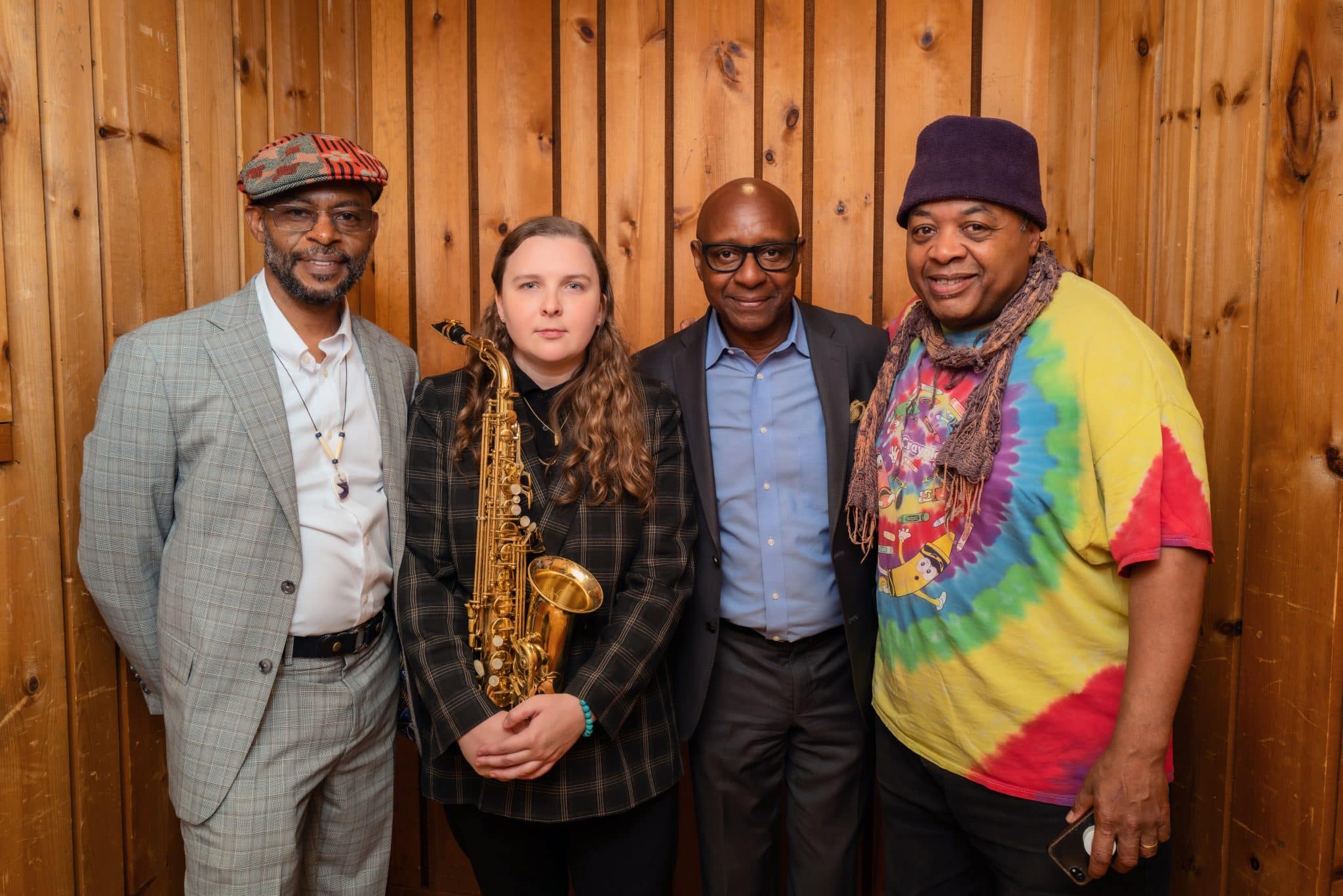The following is an interview with alto saxophonist Sarah Hanahan, conducted by jazz journalist Morgan Enos. Her debut album, Among Giants, was released 21 June via Blue Engine Records. The album features pianist Marc Cary, bassist Nat Reeves, and drummer Jeff “Tain” Watts, as well as percussionist Bobby Allende on four tracks. Links to purchase Among Giants, as well as to Hanahan’s website, can be found at the bottom of this article.
Many jazz musicians espouse a common value: to stay anchored to a tradition, but not beholden to it.
This is easier said than done, but in understanding the evolution of a single song, “We Bop!”, you can hear Sarah Hanahan successfully negotiate that terrain.
“Oh my god – it sounds completely different than when we started playing it years ago,” the alto saxophonist tells UK Jazz News. As she explains, “We Bop!” began life with just bass and drums, “so it has a completely different texture and vibe with guitar or piano or anything.”
Hanahan has played “We Bop!” with pianists Marc Carey and Benito Gonzalez, and drummer Eric McPherson. “Some people play really hard, or they’ll superimpose different chords. Some people play right down the middle, and make it feel really good with the rhythms.”
She’s proud of the final, half-time version, whose recording appears on her new album Among Giants. It fits as a microcosm of the record’s vision, which flows from John Coltrane’s “Welcome,” through originals such as “NATO” and “Honey,” through to “We Bop!”.
“New voices have pushed and pulled and conceptualised where jazz is today, but through it all, bebop has stayed constant and relevant,” Hanahan explained in the press release.
Her massive, commanding tone and beyond-her-years control cements her as a steward of bebop. Read on for a full interview with Hanahan about the album’s making.
UK Jazz News: In the press release, you mentioned that the rehearsal process leading up to the record was “unbelievably fun and easy.” Ease can be hard-won in the jazz world; what led to that sense?
Sarah Hanahan: All three of those guys, I have personal relationships with. Jeff, probably the least, but we have played with each other before. He knows how much I love his playing, so we had a nice connection.
Nat and Marc, I’ve known for years. So, when we went into the studio, those three guys were definitely there for me. However it was going to work, we were going to make an amazing record. They were super vulnerable, and they were just down; I don’t know how else to explain it. And it felt great.
You don’t exactly know what to expect, walking into a recording studio with a brand-new band; I’d only played one or two gigs with them. I just knew all three of those guys are absolute legends, and they were going to make some beautiful music together.
I showed up prepared; I showed up with all the music; I showed up with my ideas, but they each put an individual stamp on everything.
I think it really came together as a beautiful collaboration between all four of us; it sounds like we’ve been playing for years together. I think there was just a lot of love, respect and admiration in the room.
UKJN: The ramp up for a young player can be rough, especially on the New York scene. What was your early development like?
SH: I started playing when I was in high school, and I really loved to play. It was the only thing I ever did. I was an athlete and things like that, but [playing] was the only thing I did where I really felt like myself, and I took it so seriously.
When I got to college, it became an obsession. And not only that; I was around all these new people, like Nat Reeves, [saxophonist] Abraham Burton, [drummer] Eric McPherson, [trombonist] Steve Davis. People who have played with Art Blakey, Elvin Jones, Jackie McLean, Sonny Stitt. The list goes on. I was a sponge. I wanted to learn as much as I could.
Over the past 10 years I’ve been trying to learn about the tradition, but through that, pave my own path and try to figure out my own sound: who I want to be, and what I’m trying to say on the saxophone, and as a musician.
To conceptualise the debut record was a challenge. I’ve been working on it for a long time. So, it felt great to finally have some music that was like, Whoa, everything all makes sense together! [Considering] the last 10 years, I’ve come to that climax.
UKJN: How’d you conceptualise the flow of the record?
SH: I was thinking about a setlist. I want a record to flow really well from one song to the next.
Usually, I’ll start a show with something real spiritual. I started the record with “Welcome” by John Coltrane. I always like starting shows like that; we call it “bringing the spirits down.” Bringing our ancestors down, and letting them come to the show.
Another way we [describe] it is “the big room.” You start in the big room, and then you go and do your thing. I think it’s important to have that moment where you’re all together, doing something really special.
UKJN: Can you speak to the originals on Among Giants?
SH: Some of the originals were older songs I had written, and wanted to record for a few years, and some were newer, written right before the recording session.
They had a real freshness to them. Starting with “Resonance”, I wrote that a few years ago, and I was really deep into John Coltrane at the time. I was listening to [Coltrane’s posthumous albums] A Love Supreme: Live in Seattle and Blue World. I was really into the Quartet – McCoy [Tyner], Elvin [Jones] – and wanted to get in that vibe.
“NATO,” I wrote for Nat Reeves. I was thinking mostly about the bassline, and how he’s such a pro at nailing one bassline for 30 minutes. That one was about the drums, and the energy.
“Honey,” I wrote as a calypso type vibe. After we played super hard, I wanted it to be like a breath, a sigh. That one’s kind of a love song for my honey.
UKJN: How about “We Bop!”?
SH: I wrote it right after Covid. We had only been playing as a chordless trio – bass, drums and saxophone – because we were only doing outdoor gigs; we didn’t have electricity or anything.
So, I wrote “We Bop!” because I was playing so much with just drums, and it had this hip rhythm to it. Once I finally heard it with piano, the whole thing came together with a great vibe.
I actually got inspired by Roy Hargrove’s “Dream Traveler,” which is on his Habana album [from 1997]. It’s such a hip song. My favourite part of the song is where they go to this open vamp, and he solos over it. That vamp, and the congas, and the rhythm, really inspired “We Bop!”.


